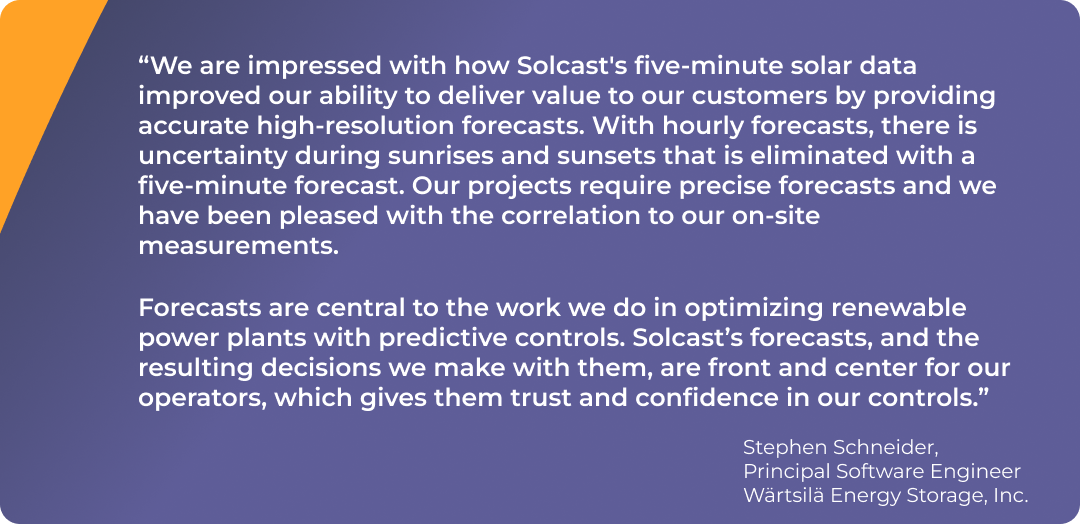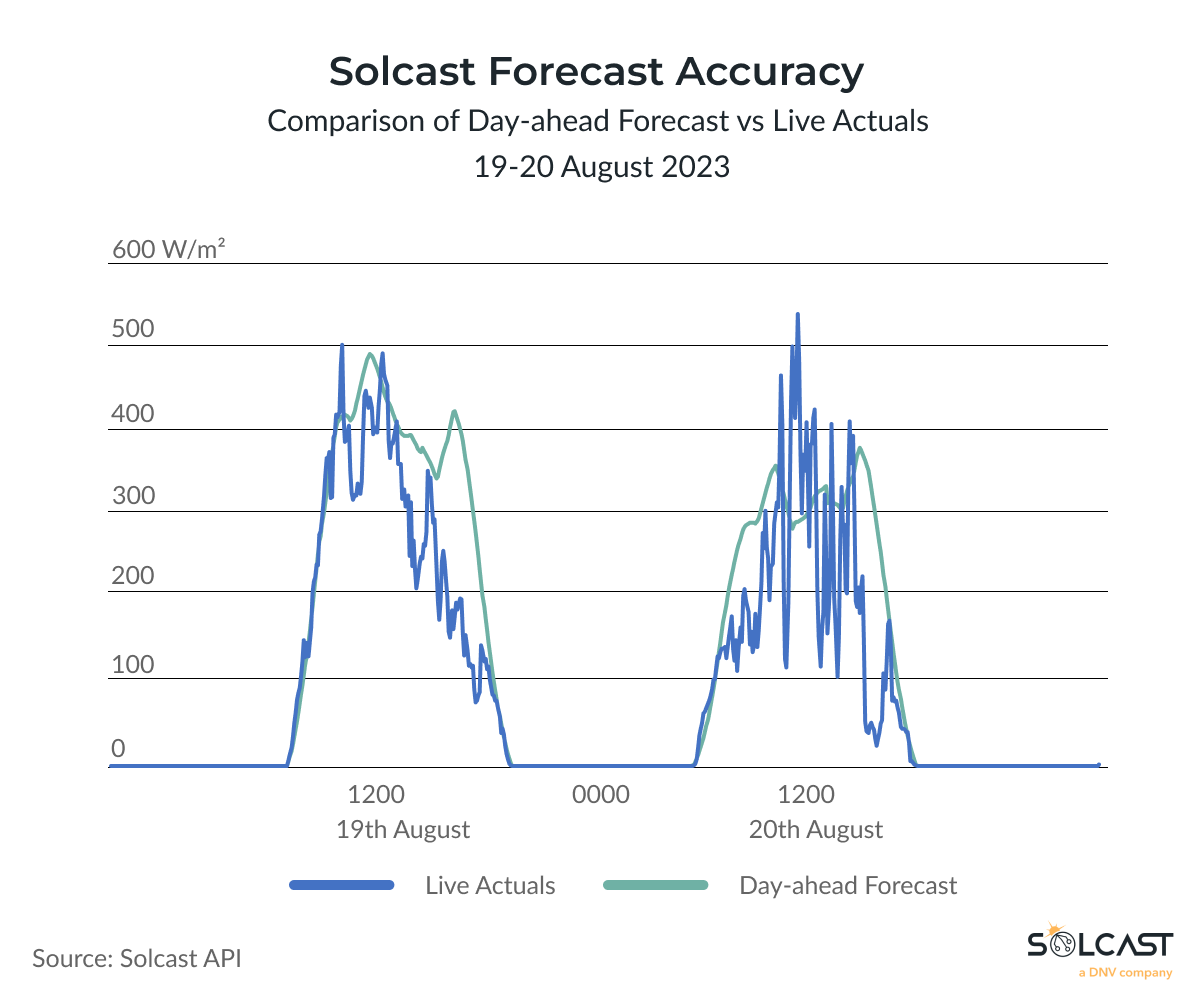“Day-ahead” forecasts are an essential tool in the operational strategy for managing solar assets. Gaining insight into tomorrow's conditions today provides clear visibility into how assets will perform tomorrow. An accurate foresight enables proactive planning today, and is a common benchmark for regulatory forecasting or assets on PPAs.
As asset operations and dispatch become more data driven and energy markets change, more solar operators are starting to look for more accurate, reliable day-ahead forecasts.

Why accurate day-ahead forecasts matter
Without an understanding of what your assets are doing tomorrow, it is hard to start planning your dispatch, work and power management. Inaccuracies in your solar forecast data can lead to inefficient power management, including curtailment, regulatory violations and associated penalties, unnecessary storage system cycles, power outages, unnecessary backup generator costs, and more.
Solcast day-ahead forecasts are used for:
Regulatory Forecasting
Compliance in operating solar assets is essential. Accurate day-ahead forecasts help meet legal and operational standards. Failure to meet these standards or to deliver the committed power can result in hefty financial penalties, curtailment and grid instability.
Grid Management
Effective grid management relies heavily on planning for and anticipating ramp events, both for the regular ramps at the start and end of each day, but also for whether solar assets are likely to be subject to cloud cover, and the sudden ramping events that can cause. Solar operators must manage not only the fluctuating weather, but also the changing consumer energy demand and prices in merchant markets. Day ahead forecasts for both individual assets and for aggregated grid generation, are essential tools utilised every day for effective grid management, by both asset and grid operators.
Asset Operations
Probabilistic day-ahead forecasting does not attempt to predict specific cloud events with precision. Instead, it helps asset operators evaluate the likelihood of different scenarios happening, providing a range of probabilities for ramp events at different times. This approach recognizes the unpredictability of weather changes while providing a more in-depth understanding of potential ramp events or conditions. Accurate forecasts ensure day-to-day site operations can be planned in advance without unnecessarily disrupting generation and while managing power supply.
With the growth of energy storage technologies, accurate forecasting is also being used to effectively plan when to store energy to maximise renewables utilisation in hybrid plants without running through unnecessary cycles in their batteries.
Power Planning in Microgrids
In microgrid applications, especially those operating independently, power planning is critical. Accurate forecasting ensures proper power distribution within microgrids, avoiding disturbances that could lead to grid instability and minimising the utilisation of fossil fuel power backups. Many micro-grids also operate without pyranometers, so combining a day-ahead forecast with live irradiance data allows for detailed power planning based on the most accurate available data.
Solcast's day-ahead and intra-day forecast data is used in this way by Wärtsilä Energy Storage Inc (WESI) in their GEMS Digital Platform. By integrating data through the Solcast API, their improved forecasting capability drives energy management decisions, ensuring efficient, stable, and reliable power for various grids, including interconnected or islanded grids. Read more about their story here.
How do you make an accurate day ahead forecast?
Building accurate forecasts for solar specific applications, requires the specific treatment of weather parameters that have an outsized impact on irradiance, like high-resolution cloud impacts, aerosols, snow soiling and terrain shading. These factors aren’t present in low resolution general weather data, and often aren’t specifically treated at all in large scale weather APIs. Snow soiling, for instance, has substantial generation impact especially on days during and after the snow. Solcast’s API factors snow soiling in to forecast the estimated soiling on panels, and when the snow is likely to slide off the panels. Similarly, aerosols and moisture refract sunlight in the atmosphere and affect the irradiance levels on the Earth’s surface. Solcast’s aerosol modelling is upscaled to 90 metre resolution and is a key factor in achieving our levels of accuracy, in particular in contrast to other day ahead models using static aerosol parameters or coarse aerosol forecasts.
Getting data at high resolution also makes a significant difference in accuracy. Solcast’s high resolution data delivers irradiance forecasts at 5 minute resolution. High temporal resolution data allows accurate planning as assets come online down to the minute. While day-ahead forecasts offer significant benefits in planning and asset management, probabilistic day-ahead forecasts also provide additional insights in predicting the probabilities of ramp events due to cloud cover.
Terrain shading and elevation data down to 90m resolution make it possible to separately forecast how distributed energy systems will come online based on different elevations or horizon profiles, increasing the accuracy and reliability of the data.

How accurate is your day-ahead forecast?
As global solar capacity increases, the demand for accurate and quality data control grows.
Our team is always working and innovating to improve our API models to provide highly accurate data. Our forecast accuracy and validation page provides the detail of this assessment, but below is summarised a 33 site study of Solcast Forecast data compared to two other methods.
| Site type | Data source | +1 hours ahead error (%) Mean & range |
+2 hours ahead error (%) Mean & range |
Day-ahead (+24hr) error (%) Mean & range |
|---|---|---|---|---|
| Global average (all 33 sites) | Solcast | 2.9% (1.4% to 5.0%) |
4.1% (2.5% to 6.2%) |
5.1% (2.9% to 8.2%) |
| Smart Persistence | 4.0% (2.0% to 6.3%) |
5.2% (2.6% to 7.4%) |
9.0% (3.8% to 14.0%) |
|
| GFS | 6.0% (3.3% to 9.2%) |
|||
The graph below depicts a sample of Solcast’s day-ahead forecast accuracy on two cloudy days, showing how the forecast data closely mirrors the trend of live actuals and accurately predicts the shape of the irradiance curve. This high-resolution day-ahead forecast captures the morning and afternoon ramps well, and indicates that cloud is likely, with several peaks and troughs through the day. This visibility gives asset operators early notice of a high-variability day, allowing them to make decisions that drive improved power supply management, dispatch planning, and efficient energy storage.

Forecast accuracy varies by site, weather conditions and over time, and choosing the right data sources can be critical to your commercial outcomes. The best way to determine the data you need is with a detailed evaluation of the documentation, data, existing validations and looking at the data in detail. Our team have supported more than 350 customers that manage more than 300GW of assets globally in their assessment of Solcast data and would love to share our insights with you. You can request a quote to discuss that with them, or get started yourself and review our historical, live and forecast data for free through a commercial toolkit account.
